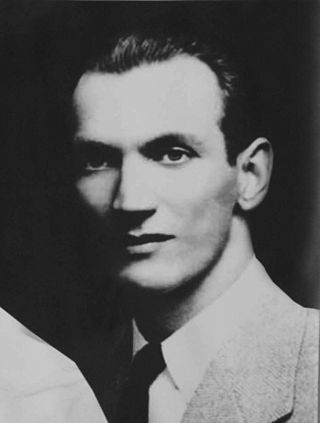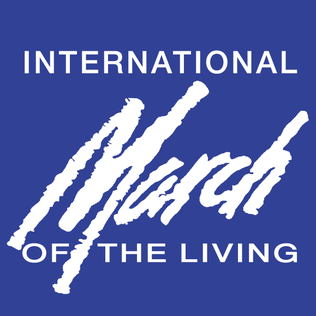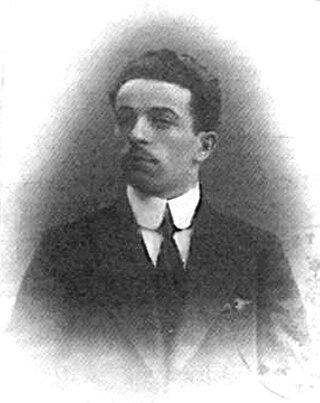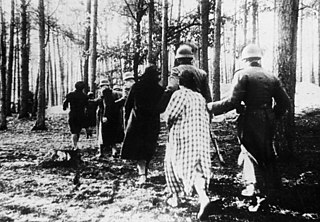
Majdanek was a Nazi concentration and extermination camp built and operated by the SS on the outskirts of the city of Lublin during the German occupation of Poland in World War II. It had seven gas chambers, two wooden gallows, and some 227 structures in all, placing it among the largest of Nazi concentration camps. Although initially intended for forced labor rather than extermination, it was used to murder people on an industrial scale during Operation Reinhard, the German plan to murder all Polish Jews within their own occupied homeland. In operation from 1 October 1941 to 22 July 1944, it was captured nearly intact. The rapid advance of the Soviet Red Army during Operation Bagration prevented the SS from destroying most of its infrastructure, and Deputy Camp Commandant Anton Thernes failed to remove the most incriminating evidence of war crimes.

Jan Karski was a Polish soldier, resistance-fighter, and diplomat during World War II. He is known for having acted as a courier in 1940–1943 to the Polish government-in-exile and to Poland's Western Allies about the situation in German-occupied Poland. He reported about the state of Poland, its many competing resistance factions, and also about Germany's destruction of the Warsaw Ghetto and its operation of extermination camps on Polish soil that were murdering Jews, Poles, and others.

Gross-Rosen was a network of Nazi concentration camps built and operated by Nazi Germany during World War II. The main camp was located in the German village of Gross-Rosen, now the modern-day Rogoźnica in Lower Silesian Voivodeship, Poland, directly on the rail-line between the towns of Jawor (Jauer) and Strzegom (Striegau). Its prisoners were mostly Jews, Poles and Soviet citizens.

The Warsaw Ghetto Uprising was the 1943 act of Jewish resistance in the Warsaw Ghetto in German-occupied Poland during World War II to oppose Nazi Germany's final effort to transport the remaining ghetto population to the gas chambers of the Majdanek and Treblinka extermination camps.

The Warsaw concentration camp was a German concentration camp in occupied Poland during World War II. It was formed on the base of the now-nonexistent Gęsiówka prison, in what is today the Warsaw neighbourhood of Muranów, on the order of Reichsführer-SS Heinrich Himmler. The camp operated from July 1943 to August 1944.

Gęsiówka is the colloquial Polish name for a prison that once existed on Gęsia ("Goose") Street in Warsaw, Poland, and which, under German occupation during World War II, became a Nazi concentration camp.

Pawiak was a prison built in 1835 in Warsaw, Congress Poland.
This is a selected bibliography and other resources for The Holocaust, including prominent primary sources, historical studies, notable survivor accounts and autobiographies, as well as other documentation and further hypotheses.
The Holocaust has been a prominent subject of art and literature throughout the second half of the twentieth century. There is a wide range of ways–including dance, film, literature, music, and television–in which the Holocaust has been represented in the arts and popular culture.

The March of the Living is an annual educational program which brings students from around the world to Poland, where they explore the remnants of the Holocaust. On Holocaust Memorial Day observed in the Jewish calendar, thousands of participants march silently from Auschwitz to Birkenau.

Jewish resistance under Nazi rule took various forms of organized underground activities conducted against German occupation regimes in Europe by Jews during World War II. According to historian Yehuda Bauer, Jewish resistance was defined as actions that were taken against all laws and actions acted by Germans. The term is particularly connected with the Holocaust and includes a multitude of different social responses by those oppressed, as well as both passive and armed resistance conducted by Jews themselves.
Operation Heads was the code name for a series of assassinations of Nazi officials by the World War II Polish Resistance. Those targeted for assassination had been sentenced to death by Polish Underground Special Courts for crimes against Polish citizens during the World War II German occupation of Poland. The operation's code name, literally "Operation Little Heads", was a sardonic reference to the Totenkopf insignia on Nazi German SS uniforms and headgear.

Mary Berg was a survivor of the Warsaw Ghetto and author of a Holocaust diary, which contains her personal journal entries written between October 10, 1939, and March 5, 1944, during the occupation of Poland in World War II.

Samuel Willenberg, nom de guerreIgo, was a Polish Holocaust survivor, artist, and writer. He was a Sonderkommando at the Treblinka extermination camp and participated in the unit's planned revolt in August 1943. While 300 escaped, about 79 were known to survive the war. Willenberg reached Warsaw where, before war's end, he took part in the Warsaw Uprising. At his death, Willenberg was the last survivor of the August 1943 Treblinka prisoners' revolt.

Berek Lajcher was a Jewish physician and social activist from Wyszków before the Holocaust in Poland, remembered for his leadership in the prisoner uprising at Treblinka extermination camp. More than 800,000 Jews, as well as unknown numbers of Romani people, were murdered at Treblinka in the course of Operation Reinhard in World War II.
Of the six million Jews killed during the Holocaust, two million were women. Between 1941 and 1945, Jewish women were imprisoned in Nazi concentration camps or hiding to avoid capture by the Nazis under Adolf Hitler's regime in Germany. They were also sexually harassed, raped, verbally abused, beaten, and used for Nazi human experimentation. Jewish women had a sizable and distinct role in the resistance and partisan groups.

The Palmiry massacre was a series of mass executions carried out by Nazi German forces, during World War II, near the village of Palmiry in the Kampinos Forest northwest of Warsaw.

Blind Love: A Holocaust Journey Through Poland with Man's Best Friend is a 2015 documentary film about blind Israelis traveling to Poland with the help of their guide dogs, to learn about the Holocaust. Footage includes blind participants taking part in the 2012 and 2013 March of the Living programs. The film is narrated by Michael Enright of the Canadian Broadcasting Corp.

Stefanja Orlowska is an Australian actress and writer. She made her film debut in 2011, in the independent film Minds, Adolescents. She is most known for her role as Halina in the documentary film There Is Many Like Us.

Chasing the King of Hearts is a historical novel written by Hanna Krall. The novel was originally published in Polish as Król kier znów na wylocie in 2006 and was translated into English by Phillip Boehm as Chasing the King of Hearts in 2013. It follows the life story of Izolda Regensberg during the Holocaust in vignettes, short chapters often less than a page long.

















